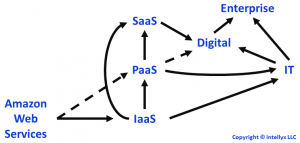Amazon Web Services (AWS), the Amazon.com cloud computing juggernaut, wrapped up its annual reInvent conference in Las Vegas last week. Host to many thousands of AWS devotees, hundreds of exhibiting partners, and dozens of press and analysts – but not myself. You see, I wasn’t invited.
Not for want of trying, mind you. It didn’t matter that I had attended last year as an analyst, or that I write about them regularly, or even that my opinion of them has generally been quite favorable. You’d think that with my new role as contributor to Forbes on the topic of digital transformation, I’d be a shoe-in for one of the coveted press/analyst passes. Didn’t happen.
Determined not to fall for a sour grapes trap, I spent the week following the goings-on at reInvent anyway, paying special attention to Amazon’s announcements at the show. After all, AWS saves its most significant product launches for reInvent, signaling their strategy for the coming year.
A handful of security and compliance tools. Three new application lifecycle management tools. Yet another cloud-based database. And a container service for all you Docker fans out there. The techies in the crowd went home happy to be sure.
Then it dawned on me. Amazon didn’t exclude me in spite of my focus on digital transformation. They chose not to invite me precisely because my focus is on digital. You see, for better or worse, AWS has no real digital story to tell. And therein lies the true AWS digital story.
Amazon Web Services’ Value Chain
Today, the word digital refers to the fact that human behavior and preferences drive technology use and selection, which in turn drive how companies must interact with their customers. In other words, digital strategies center on the end-user customer.
AWS, however, sees itself primarily as an Infrastructure-as-a-Service (IaaS) cloud provider, offering cloud infrastructure services to a global community of developers and operations professionals. In fact, AWS’s traditional customer base are Platform-as-a-Service (PaaS) and Software-as-a-Service (SaaS) providers who build cloud-based offerings on top of the Amazon infrastructure cloud.
However, Amazon clearly realizes their growth depends upon enterprise customers. Large enterprises – banks, manufacturers, pharmas, insurance companies, etc. – represent AWS’s comparatively newer battleground, as Amazon seeks to expand their already immense cloud business.
This year’s reInvent emphasized the keystone of AWS’s enterprise strategy: target the IT shops. After all, IT is where enterprise developers and ops folks traditionally fit into the organization, and furthermore, enterprise IT has traditionally been responsible for IT infrastructure, as well as security and IT compliance. Placed into this context, this fall’s crop of product announcements make perfect sense.
However, AWS chose not to offer any new products for enterprise digital professionals outside the traditional IT organization. These folks typically work under the Chief Marketing Officer or the Chief Digital Officer, or sometimes under a VP of Ecommerce or similar executive – but regardless of the reporting structure, today’s digital efforts frequently fall outside the traditional IT organization, and focus more on the user experience than on the underlying technology infrastructure.
Digital teams are still able to take advantage of AWS, but not directly. Amazon’s strategy to serve these customers is through an indirect channel, as the following diagram illustrates.
 Amazon Web Services’ Cloud Value Chain
Amazon Web Services’ Cloud Value Chain
Read the entire article at http://www.forbes.com/sites/jasonbloomberg/2014/11/15/amazons-cloud-computing-digital-blind-spot/.



